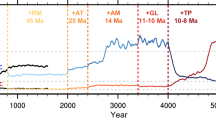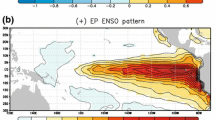Abstract
How climate changes will modify the behavior of El Niño/Southern Oscillation (ENSO) is one of the important questions in future climate projections. An investigation under different climate forcing gives us a good insight on the mechanism of ENSO variability and its changes. In this paper, sensitivity on ENSO by progressive mountain uplift is investigated with an atmosphere–ocean coupled general circulation model. We used eight different mountain heights: 0% (no mountain), 20, 40, 60, 80, 100 (control run), 120, and 140%. Land–sea distribution is the same for all experiments and all mountains in the world are uniformly varied. Systematic changes in precipitation and circulation fields as well as SST are obtained with progressive mountain uplift. In the summertime, the precipitation area moved inland of the Asian continent with mountain uplift, while the Pacific subtropical anticyclone and associated trade winds became stronger. The western Pacific warm pool and ENSO also systematically changed. When the mountain height is low, a warm pool is located over the central Pacific due to weak trade winds in the Pacific. The model ENSO is strongest, its frequency longest, and is most periodic in the no mountain run. The model ENSO becomes weaker, shorter and less periodic when the mountain height increases. Strengthening the mean state trade winds and narrowing meridional extent of equatorial wind and ocean response by mountain uplift would be responsible for ENSO modulation.










Similar content being viewed by others
References
Abe M, Yasunari T, Kitoh A (2004) Effects of large-scale orography on the coupled atmosphere–ocean system in the tropical Indian and Pacific Oceans in boreal summer. J Meteorol Soc Jpn 82:745–759
An SI, Wang B (2000) Interdecadal change of the structure of the ENSO mode and its impact on the ENSO frequency. J Clim 13:2044–2055
Cane MA (2005) The evolution of El Niño, past and future. Earth Plane Sci Lett 230:227–240
Cane MS, Münnich M, Zebiak SE (1990) A study of self-excited oscillations of the tropical ocean–atmosphere system. Part I: linear analysis. J Atmos Sci 47:1562–1577
Crowley TJ, Burke KC (1998) Tectonic boundary conditions for climate reconstructions. Oxford University Press, New York, p 285
Crucifix M, Braconnot P, Harrison SP, Otto-Bliesner B (2005) Second phase of paleoclimate modelling intercomparison project. Eos, Trans Am Geophys Union 86:264–265
Guilyardi E (2006) El Niño–mean state–seasonal cycle interactions in a multi-model ensemble. Clim Dyn 26:329––348
Hu Z-Z, Schneider EK, Bhatt US, Kirtman BP (2004) Potential mechanism for response of El Niño-Southern Oscillation variability to change in land surface energy budget. J Geophys Res 109:D21113. DOI 10.1029/2004JD004771
Jin F-F (1997) An equatorial recharge paradigm for ENSO, Part I, conceptual model. J Atmos Sci 54:811–829
Kalnay E, Coauthors (1996) The NCEP/NCAR 40 year reanalysis project. Bull Am Meteor Soc 77:437–471
Kitoh A (1997) Mountain uplift and surface temperature changes. Geophys Res Lett 24:185–188
Kitoh A (2002) Effects of large-scale mountains on surface climate—a coupled ocean–atmosphere general circulation model study. J Meteorol Soc Jpn 80:1165–1181
Kitoh A (2004) Effects of mountain uplift on East Asian summer climate investigated by a coupled atmosphere–ocean GCM. J Clim 17:783–802
Kitoh A, Motoi T, Murakami S (2006) El Niño/Southern Oscillation simulation at 6,000 years B.P. with the MRI-CGCM2.3: effect of flux adjustment. J Clim (in press)
Meehl GA, Teng H, Branstator G (2006) Future changes of El Niño in two global coupled climate models. Clim Dyn 26:549–566
Merryfield W (2006) Changes to ENSO under CO2 doubling in a multi-model ensemble. J Clim (in press)
Neelin JD, Dijkstra HA, (1995) Ocean–atmosphere interaction and the tropical climatology. Part I: the dangers of flux correction. J Clim 8:1325–1342
Neelin JD, Battisti DS, Hirst AC, Jin FF, Wakata Y, Yamagata T, Zebiak SE (1998) ENSO theory. J Geophys Res 103:14261–14290
van Oldenborgh GJ, Philip S, Collins M (2005) El Niño in a changing climate: a multi-model study. Ocean Sci 1:81–95
Rajendran K, Kitoh A, Yukimoto S (2004) South and East Asian summer monsoon climate and variation in MRI coupled model (MRI-CGCM2). J Clim 17:763–782
Rayner NA, Parker DE, Horton EB, Folland CK, Alexander LV, Rowell DP, Kent EC, Kaplan A (2003) Global analyses of sea surface temperature, sea ice, and night marine air temperature since the late nineteenth century. J Geophys Res 108:4407. DOI 10.1029/2002JD002670
Rodbell DT, Seltzer GO, Anderson DM, Abbott MB, Enfield DB, Newman JH (1999) An ∼15,000 year record of El Niño-driven alluviation in southwestern Ecuador. Science 283:516–520
Ropelewski CF, Halpert MS (1989) Precipitation patterns associated with the high index phase of the Southern Oscillation. J Clim 2:268–284
Sun DZ, Zhang T, Shin S-I (2004) The effect of subtropical cooling on the amplitude of ENSO: a numerical study. J Clim 17:3786–3798
Timmermann A, Oberhuber J, Bacher A, Esch M, Latif M, Roeckner E (1999) Increased El Niño frequency in a climate model forced by future greenhouse warming. Nature 398:694–697
Timmermann A, Jin FF, Collins M (2004) Intensification of the annual cycle in the tropical Pacific due to greenhouse warming. Geophys Res Lett 31: L12208. DOI 10.1029/2004GL019442
Xie P, Arkin P (1996) Analysis of global monthly precipitation using gauge observations, satellite estimates and numerical model predictions. J Clim 9:840–858
Yang H, Zhang Q, Zhong Y, Vavrus S, Liu Z (2005) How does extratropical warming affect ENSO? Geophys Res Lett 32: L01702. DOI 10.1029/2004GL021624
Yukimoto S, Noda A, Kitoh A, Sugi M, Kitamura Y, Hosaka M, Shibata K, Maeda S, Uchiyama T (2001) The new Meteorological Research Institute coupled GCM (MRI-CGCM2)—model climate and variability. Pap Meteorol Geophys 51:47–88
Zelle H, van Oldenborgh GJ, Burgers G, Dijkstra HA (2005) El Niño and greenhouse warming; results from ensemble simulations with the NCAR CCSM. J Clim 18:4669–4683
Acknowledgments
The author would like to thank Dr. Axel Timmermann and an anonymous reviewer for constructive comments. This work was partially supported by Grants-in-Aid for Scientific Research No. 17540420.
Author information
Authors and Affiliations
Corresponding author
Rights and permissions
About this article
Cite this article
Kitoh, A. ENSO modulation by mountain uplift. Clim Dyn 28, 781–796 (2007). https://doi.org/10.1007/s00382-006-0209-6
Received:
Accepted:
Published:
Issue Date:
DOI: https://doi.org/10.1007/s00382-006-0209-6




